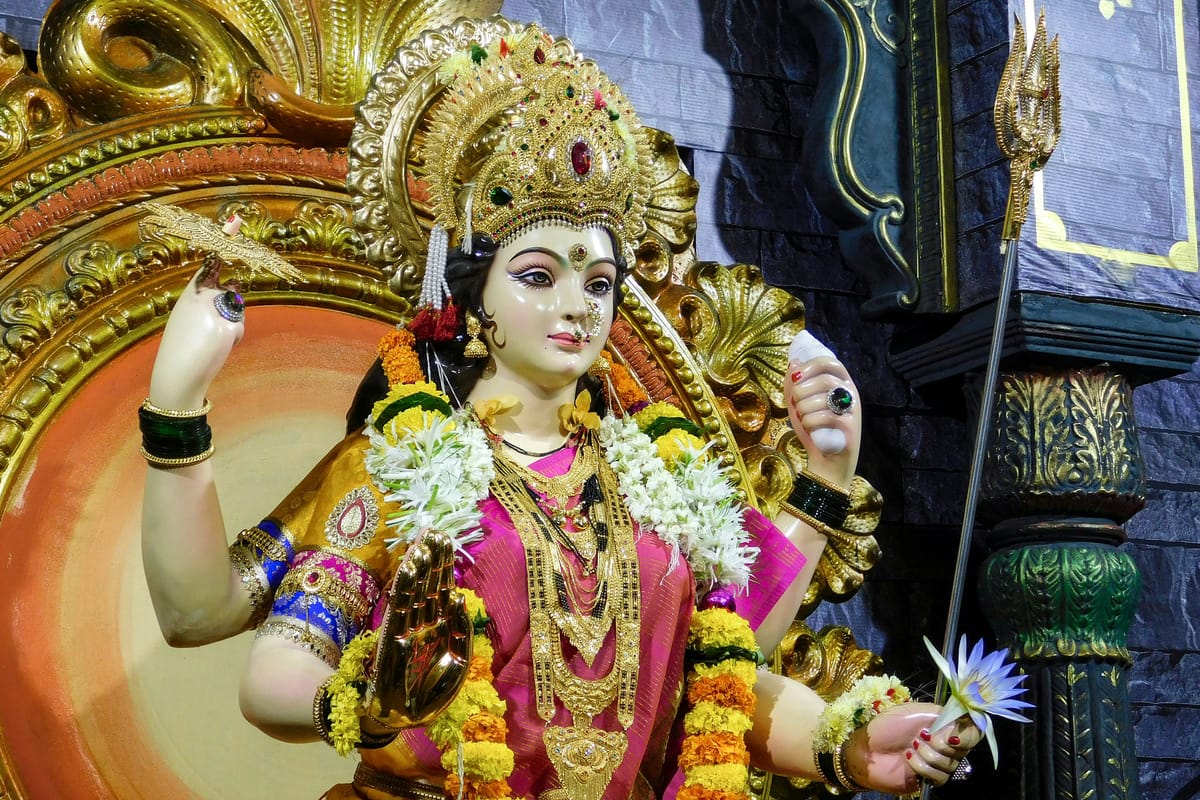The Kena Upanishad: A Srividya Perspective

Introduction
The Kena Upanishad, one of the foundational texts in Vedanta philosophy, explores profound metaphysical questions about the nature of Brahman (the Supreme Reality) and the individual soul. Its dialogue format engages the reader in a contemplative journey, leading to the ultimate realization of non-duality (Advaita). While the Upanishad itself does not explicitly align with any particular sect, its teachings resonate deeply with the principles of Srividya, a distinguished path within the Shakti tradition. This essay explores how the Kena Upanishad can be appreciated from a Srividya perspective, and how the practices and philosophies of Srividya prepare the aspirant for the realization of Advaita Vedanta.
Srividya: An Overview
Srividya is a highly esoteric and comprehensive spiritual tradition that centers around the worship of the Goddess Lalita Tripurasundari, the supreme deity embodying both immanence and transcendence. Srividya encompasses a wide array of practices, including mantra, tantra, yantra, and ritual worship, all designed to lead the practitioner to a direct experience of the divine. At its core, Srividya is not just about external worship but about internal transformation and the realization of the non-dual nature of reality.
The Philosophical Foundations
Srividya is deeply rooted in the non-dualistic philosophy of Advaita Vedanta, which posits that there is no separation between the individual soul (Atman) and the ultimate reality (Brahman). The ultimate aim of Srividya practices is to transcend the illusion of duality and realize the unity of the self with the supreme consciousness.
The Role of Shakti
In Srividya, Shakti, the dynamic feminine aspect of the divine, is seen as both the means and the goal. The practitioner engages with Shakti through various forms of worship, seeking her grace and guidance. This engagement purifies the mind and prepares the aspirant for the highest realization of Advaita, where Shakti and Shiva (the static masculine aspect) are understood as inseparably one.
The Kena Upanishad: An Examination
Opening Invocation
The Kena Upanishad begins with a peace invocation that seeks physical and mental well-being, essential for any spiritual practice:
Sanskrit:
ॐ आप्यायन्तुममाङ्गानि वाक्प्राणश्चक्षुः
श्रोत्रमथोबलमिन्द्रियाणि च सर्वाणि ।
सर्वं ब्रह्मौपनिषदं
माऽहं ब्रह्म निराकुर्यां मा मा ब्रह्म
निराकरोदनिराकरणमस्त्वनिराकरणं मेऽस्तु।
तदात्मनि निरतेय
उपनिषत्सुधर्मास्तेमयि सन्तुतेमयि सन्तु।
ॐ शान्तिः शान्तिः शान्तिः ॥
Translation:
Om. May my limbs, speech, prana (life-force), eyes, ears, strength, and all the senses grow vigorous. All is Brahman as declared in the Upanishads. May I never deny Brahman; may Brahman never deny me. Let there be no denial at all. Let me be in union with Brahman, who is the Self. May all virtues described in the Upanishads dwell in me, who am devoted to the Self. Om, peace, peace, peace.
Commentary:
This invocation aligns with the holistic approach of Srividya, which emphasizes the integration of physical, mental, and spiritual health. Just as the invocation seeks the vitality of the body and senses, Srividya practices aim to purify and empower the practitioner's entire being, preparing them for higher spiritual insights.
The Inquiry into Brahman
Sanskrit:
ॐ केनेषितं पतति प्रेषितं मनः
केन प्राणः प्रथमः प्रैति युक्तः ।
केनेषितां वाचमिमां वदन्ति
चक्षुः श्रोत्रं क उ देवोयुनक्ति ॥ १॥
Translation:
By whom willed and directed does the mind go towards its objects? By whom directed does the vital force (prana) proceed to its function? By whom willed do men utter speech? What intelligent being directs the eye and the ear?
Commentary:
This verse sets the stage for the profound inquiry into the nature of consciousness. In Srividya, this inquiry is mirrored in the contemplation of the Goddess as the source of all creation and consciousness. The practitioner is encouraged to look beyond the surface of sensory experiences and recognize the divine will and intelligence (Shakti) that animates all functions.
The Essence of Brahman
Sanskrit:
श्रोत्रस्य श्रोत्रं मनसोमनोयद्
वाचोह वाचं स उ प्राणस्य प्राणः ।
चक्षुषश्चक्षुरतिमुच्य धीराः
प्रेत्यास्माल्लोकादमृता भवन्ति ॥ २॥
Translation:
That which is the Ear of the ear, the Mind of the mind, the Speech of speech, the Life of life, and the Eye of the eye. Having realized this, the wise transcend this world and become immortal.
Commentary:
Here, the Upanishad points to Brahman as the ultimate source behind all sensory and mental faculties. In Srividya, this understanding is essential as the practitioner seeks to recognize the divine presence (Shakti) in every aspect of existence. The realization that all faculties are expressions of Shakti leads to the transcendence of limited individuality and the attainment of spiritual immortality.
Beyond Intellectual Understanding
Sanskrit:
न तत्र चक्षुर्गच्छति न वाग्गच्छति नोमनः ।
न विद्मो न विजानीमो यथैतदनुशिष्यात् ॥ ३॥
Translation:
There, the eye does not go, nor speech, nor the mind. We do not know, nor do we understand how to instruct about it.
Commentary:
This verse emphasizes the limitations of sensory perception and intellectual understanding in grasping the nature of Brahman. In Srividya, this is akin to the mystical experiences where the divine cannot be fully comprehended through ordinary means. The practices of Srividya, therefore, are designed to transcend these limitations through direct, experiential knowledge of the Goddess.
The Paradox of Knowledge
Sanskrit:
अन्यदेव तद्विदितादथोअविदितादधि ।
इति शुश्रुम पूर्वेषां येनस्तद्व्याचचक्षिरे॥ ४॥
Translation:
It is indeed different from the known and also it is beyond the unknown. Thus, we have heard from the ancient sages who explained it to us.
Commentary:
Brahman is described as beyond the dualities of known and unknown, pointing to its transcendent nature. In Srividya, this aligns with the understanding of the Goddess as the ultimate mystery, transcending all dualities. The path of Srividya involves navigating these paradoxes through devotion and mystical practices that reveal deeper layers of truth.
Experiencing Brahman
Sanskrit:
यद्वाचाऽनभ्युदितं येन वागभ्युद्यते।
तदेव ब्रह्म त्वं विद्धि नेदं यदिदमुपासते॥ ५॥
Translation:
That which cannot be expressed by speech, but by which speech is expressed – know that alone as Brahman and notwhat people here worship.
Commentary:
This teaching directs the seeker to look beyond the superficial worship and understand the essence that cannot be captured by words. In Srividya, this is akin to moving from external rituals to internal realization, where the true worship of the Goddess transcends forms and rituals, leading to the direct experience of her presence.
The Mind Beyond the Mind
Sanskrit:
यन्मनसा न मनुते येनाहुर्मनोमतम् ।
तदेव ब्रह्म त्वं विद्धि नेदं यदिदमुपासते॥ ६॥
Translation:
That which cannot be thought by the mind, but by which, they say, the mind thinks – know that alone as Brahman and not what people here worship.
Commentary:
The Upanishad continues to emphasize the limitations of the mind in understanding Brahman. In Srividya, the practitioner is guided to transcend the mental plane through deep meditation and contemplation of the Goddess, ultimately leading to the realization that the mind itself is a manifestation of the divine.
The Sight Beyond Sight
Sanskrit:
यच्चक्षुषा न पश्यति येन चक्षूंषि पश्यति ।
तदेव ब्रह्म त्वं विद्धि नेदं यदिदमुपासते॥ ७॥
Translation:
That which cannot be seen by the eye, but by which the eyes see – know that alone as Brahman and not what people here worship.
Commentary:
This verse highlights the principle that Brahman is the ultimate seer, beyond the sensory organs. In Srividya, this understanding is cultivated through practices that shift focus from external objects to the inner vision of the divine. The worship of the Goddess involves recognizing her as the inner light that illumines all perception.
The Hearing Beyond Hearing
Sanskrit:
यच्छ्रोत्रेण न शृणोति येन श्रोत्रमिदं श्रुतम् ।
तदेव ब्रह्म त्वं विद्धि नेदं यदिदमुपासते॥ ८॥
Translation:
That which cannot be heard by the ear, but by which the ears hear – know that alone as Brahman and not what people here worship.
Commentary:
The Upanishad reiterates that Brahman is the true hearer behind the sense of hearing. In Srividya, this teaching is reflected in the use of sacred sounds and mantras. The practitioner learns to listen to the divine within, recognizing the Goddess as the source of all sound and silence.
The Breath Beyond Breath
Sanskrit:
यत्प्राणेन न प्राणिति येन प्राणः प्रणीयते।
तदेव ब्रह्म त्वं विद्धि नेदं यदिदमुपासते॥ ९॥
Translation:
That which cannot be lived by the life-force (prana), but by which the life-force lives – know that alone as Brahman and not what people here worship.
Commentary:
Brahman is described as the ultimate source of life itself. In Srividya, the control and regulation of prana through yogic practices serve to connect the practitioner with the divine life force. This realization helps the aspirant see the Goddess as the vital energy that sustains all life.
Knowledge and Ignorance
Sanskrit:
यदि मन्यसेसुवेदेति दहरमेवापि नूनं त्वं वेत्थ ब्रह्मणोरूपम् ।
यदस्य त्वं यदस्य देवेष्वथ नु मीमाँस्यमेव तेमन्येविदितम् ॥ १॥
Translation:
If you think you know it well, you have known only a very little. The form of Brahman that you see in living beings and in the gods – that is what needs to be known.
Commentary:
This verse challenges the notion of complete knowledge, suggesting that true understanding of Brahman is ever-deepening. In Srividya, this humility is crucial as the practitioner constantly seeks deeper revelations of the Goddess's nature. The path is seen as an ongoing journey rather than a final destination.
The Paradox of Knowing Brahman
Sanskrit:
नाहं मन्येसुवेदेति नोन वेदेति वेद च ।
योनस्तद्वेद तद्वेद नोन वेदेति वेद च ॥ २॥
Translation:
I do not think I know it well, nor do I think that I do not know it. He among us who understands that knows it, knows it, and also does not know it.
Commentary:
This verse highlights the paradoxical nature of knowing Brahman, combining knowledge and ignorance. In Srividya, this aligns with the mystical experiences where direct knowledge of the Goddess often transcends logical understanding. The practitioner learns to embrace this paradox, recognizing that the divine cannot be fully grasped by the intellect.
The Nature of True Knowledge
Sanskrit:
यस्यामतं तस्य मतं मतं यस्य न वेद सः ।
अविज्ञातं विजानतां विज्ञातमविजानताम् ॥ ३॥
Translation:
He who thinks he knows it, knows it not. He who knows that he cannot know it, knows it. The unknown to the wise, the known to the ignorant.
Commentary:
The Upanishad reiterates the elusive nature of Brahman, suggesting that true wisdom involves recognizing one's limitations. In Srividya, this humility is crucial for receiving the grace of the Goddess. The practitioner realizes that intellectual arrogance hinders spiritual progress, while openness and humility invite deeper insights.
Transcendence through Knowledge
Sanskrit:
प्रतिबोधविदितं मतममृतत्वं हि विन्दते।
आत्मना विन्दतेवीर्यं विद्यया विन्दतेऽमृतम् ॥ ४॥
Translation:
Brahman is known when It is realized in every state of mind. By such knowledge, one attains immortality. Through the Self, one gains strength; through knowledge, one attains immortality.
Commentary:
This verse emphasizes that Brahman is realized in all states of consciousness, leading to spiritual immortality. In Srividya, this understanding is cultivated through continuous meditation on the Goddess, recognizing her presence in every experience. The practices strengthen the practitioner's inner self, leading to the ultimate realization of unity with the divine.
The Importance of Realization
Sanskrit:
इह चेदवेदीदथ सत्यमस्ति
न चेदिहावेदीन्महती विनष्टिः ।
भूतेषुभूतेषुविचित्य धीराः
प्रेत्यास्माल्लोकादमृता भवन्ति ॥ ५॥
Translation:
If here one knows it, then there is truth; if here one knows it not, there is great loss. The wise who see the Self in all beings, for them there is eternal peace.
Commentary:
The Upanishad stresses the importance of realizing Brahman in this life. In Srividya, this is mirrored in the urgency of experiencing the divine in every moment. The practices are designed to awaken the practitioner's awareness of the Goddess in all aspects of life, leading to lasting peace and liberation.
The Ultimate Victory
Sanskrit:
ब्रह्म ह देवेभ्योविजिग्येतस्य ह ब्रह्मणो विजयेदेवा अमहीयन्त ॥ १॥
त ऐक्षन्तास्माकमेवायं विजयोऽस्माकमेवायं महिमेति ।
तद्धैषां विजज्ञौतेभ्योह प्रादुर्बभूव तन्न व्यजानत किमिदं यक्षमिति ॥ २॥
Translation:
Brahman once won a victory for the gods. Through Brahman's victory, the gods became elated. They thought, "This victory is ours. This glory is ours." Brahman knew this, and appeared before them. But they did not know who this Spirit was.
Commentary:
This narrative underscores the theme of divine intervention and guidance. In Srividya, the Goddess's grace is seen as crucial for overcoming spiritual ignorance and achieving victory in the quest for self-realization. The practitioner's humility and devotion attract the divine presence, leading to deeper understanding and success.
The Enigma of the Divine
Sanskrit:
तेऽग्निमब्रुवञ्जातवेद एतद्विजानीहि किमिदं यक्षमिति तथेति ॥ ३॥
तदभ्यद्रवत्तमभ्यवदत्कोऽसीत्यग्निर्वा अहमस्मीत्यब्रवीज्जातवेदा वा अहमस्मीति ॥ ४॥
Translation:
They said to Fire, "O Jataveda, find out what this great Spirit is." "Yes," he said. He ran towards It and asked, "Who are you?" "I am Fire, known as Jataveda," he replied.
Commentary:
The dialogue between Fire and Brahman illustrates the limitations of even powerful deities in understanding the supreme reality. In Srividya, this story serves as a reminder that intellectual and spiritual powers are insufficient without the grace of the Goddess. True understanding comes from her revelation.
The Limits of Power
Sanskrit:
तस्मिँस्त्वयि किं वीर्यमित्यपीदँ सर्वं दहेयं यदिदं पृथिव्यामिति ॥ ५॥
तस्मैतृणं निदधावेतद्दहेति ।
तदुपप्रेयाय सर्वजवेन तन्न शशाक दग्धुं स तत एव निववृतेनैतदशकं विज्ञातुं यदेतद्यक्षमिति ॥ ६॥
Translation:
Brahman asked, "What power is in you?" Fire replied, "I can burn anything on earth." Brahman placed a straw before him and said, "Burn this." Fire rushed towards it with all his might, but could not burn it. He returned and said, "I cannot understand what this great Spirit is."
Commentary:
This episode highlights the inadequacy of raw power in comprehending Brahman. In Srividya, it symbolizes the need for humility and surrender. The practitioner's recognition of their limitations and dependence on the Goddess's grace is crucial for spiritual progress.
The Wind's Attempt
Sanskrit:
अथ वायुमब्रुवन्वायवेतद्विजानीहि किमेतद्यक्षमिति तथेति ॥ ७॥
तदभ्यद्रवत्तमभ्यवदत्कोऽसीति वायुर्वा अहमस्मीत्यब्रवीन्मातरिश्वा वा अहमस्मीति ॥ ८॥
Translation:
Then they said to Vayu (the wind), "O Vayu, find out what this great Spirit
is." "Yes," he said. He rushed towards It and asked, "Who are you?" "I am Vayu, known as Matarisva," he replied.
Commentary:
This continuation of the narrative emphasizes that even the wind, a powerful force in the cosmos, fails to comprehend the true nature of Brahman. In Srividya, this serves as a metaphor for the futility of trying to grasp the divine essence through mere sensory or elemental prowess. The story underlines the importance of going beyond mere physical and mental faculties to access true spiritual wisdom.
The Limits of Wind
Sanskrit:
तस्मिँस्त्वयि किं वीर्यमित्यपीदँ सर्वं वायुर्वायुरिति वा अहमस्मीति मातारिश्वा वा अहमस्मीति । तस्मैतृणं निधायैतदात्नों तान् न शशाक आदातुम् । स तत एव निववृतेनैतदशकं विज्ञातुं यदेतद्यक्षमिति ॥ ९॥
Translation:
Brahman asked, "What power is in you?" Vayu replied, "I can blow away anything on earth." Brahman placed a straw before him and said, "Blow this away." Vayu rushed towards it with all his might, but could not move it. He returned and said, "I cannot understand what this great Spirit is."
Commentary:
This episode reiterates the lesson that even powerful natural forces are limited in their capacity to comprehend Brahman. For practitioners of Srividya, it serves as a reminder that true knowledge and power come from the divine grace of the Goddess. Through her, they can transcend the limitations of the material world.
Indra's Quest
Sanskrit:
अथेदं नस्तत्त्वविज्ञानायाद्धिन्द्रः, इदानीं तत्त्वदर्शनायाध्येत्य, स तस्मिन्नेवाकाशे स्तिमित्रेऽत्र प्रतततिष्ठन् न यत्किञ्चिदग्नीः, तस्मै सत्त्ववतामागत्या तत्सर्वं विहितं यदेतदेकम् ॥
Translation:
Then the gods said to Indra, "O Indra, find out what this great Spirit is." "Yes," he said. He approached Brahman and it disappeared. Indra remained in the same space and meditated upon it.
Commentary:
Indra’s approach signifies a deeper level of inquiry, one that involves meditation and contemplation rather than mere interaction. In Srividya, this transition from external efforts to internal meditation mirrors the aspirant’s journey. By meditating on the Goddess, practitioners move closer to experiencing her true nature beyond the sensory world.
The Revelation to Indra
Sanskrit:
तस्मिन्नेवाकाशे स्तिमिते तद्वेदविद्यान्तरमिति यदा इदं ज्ञानमव्यक्तमसृजत पुरोगुणं ब्रह्मणस्तत्त्वतोऽविज्ञानं प्रत्यविश्नोमीति ॥ १०॥
Translation:
In the same space where Brahman had disappeared, Indra meditated and Brahman appeared to him as a beautiful woman. She was the spirit of knowledge, revealing the ultimate reality to Indra.
Commentary:
Brahman revealing itself as a beautiful woman aligns with the Srividya tradition, where the Goddess embodies the ultimate knowledge and truth. Indra’s vision signifies that the highest truths are often revealed in forms that transcend conventional understanding. For Srividya practitioners, this underscores the importance of divine grace and revelation in achieving spiritual wisdom.
The Ultimate Teaching
Sanskrit:
तां होवाच विद्यान्तरमविज्ञानं प्रत्यविश्नोमीति, ब्रह्मेति होवाच सर्वं तपः सर्वं विज्ञानं सर्वमिदं ब्रह्मा । एतदात्मा ब्रह्म विधायतु सर्वमिति ॥ ११॥
Translation:
She said, "This knowledge that you have attained is indeed true knowledge. All this is Brahman – all penance, all knowledge, all this universe is Brahman. Realize this self as Brahman."
Commentary:
The revelation to Indra that all is Brahman encapsulates the essence of Advaita Vedanta. In Srividya, this teaching is fundamental, as all practices aim to dissolve the illusion of separation and realize the unity of the self with the Goddess. This realization is the ultimate goal, where one sees the entire universe as an expression of the divine.
Real-Life Examples
The Pursuit of Spiritual Knowledge
Consider a contemporary seeker who is deeply immersed in spiritual practices, trying to understand the nature of reality through various rituals and meditations. Despite their efforts, they often feel limited by their intellectual and sensory experiences. This reflects the initial stages of the gods’ attempts to understand Brahman through their powers.
The Role of Humility and Grace
Imagine a devoted practitioner of Srividya who, after years of disciplined practice, realizes the limitations of their personal efforts. They then surrender to the divine, seeking the grace of the Goddess to guide them. This mirrors Indra’s ultimate revelation that true knowledge comes through divine grace and humility, not through personal power alone.
Transcending Duality in Everyday Life
Think of someone who, through regular meditation and contemplation on the Goddess, begins to see the divine presence in all aspects of life – in the mundane and the extraordinary. This everyday realization of non-duality reflects the ultimate teaching of the Kena Upanishad, where one sees Brahman in everything.
Conclusion
The Kena Upanishad, with its profound inquiry into the nature of Brahman, aligns deeply with the principles of Srividya. The text’s emphasis on transcending intellectual and sensory limitations, recognizing the divine essence behind all phenomena, and the necessity of divine grace, resonates with the Srividya path. Practitioners of Srividya, through their devotion to the Goddess and disciplined practices, are prepared to realize the ultimate teachings of Advaita Vedanta – that the self and the supreme reality are one and the same.
By integrating the teachings of the Kena Upanishad with the esoteric practices of Srividya, aspirants can deepen their spiritual journey, moving from duality to the realization of non-duality, and ultimately experiencing the divine unity that underlies all existence.




